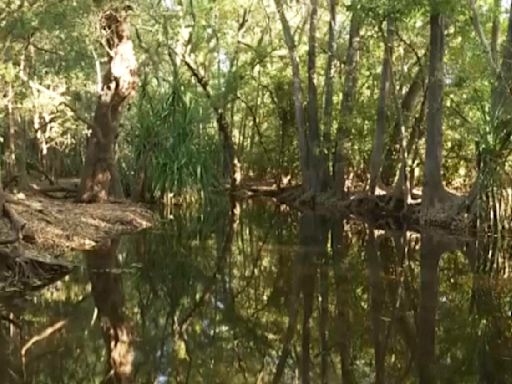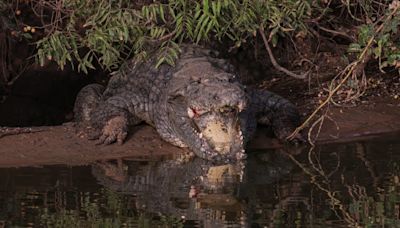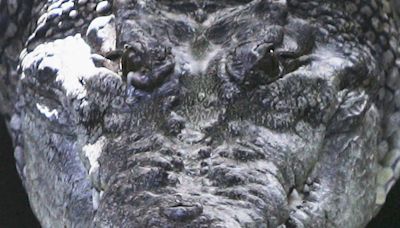Search results
The term crocodile is sometimes used even more loosely to include all extant members of the order Crocodilia, which includes the alligators and caimans (family Alligatoridae ), the gharial and false gharial (family Gavialidae) among other extinct taxa.
- Overview
- Size range and diversity of structure
- Distribution and abundance
- GeneratedCaptionsTabForHeroSec
crocodile, (order Crocodylia, or Crocodilia), any of 23 species of generally large, ponderous, amphibious animals of lizard-like appearance and carnivorous habit belonging to the reptile order Crocodylia. Crocodiles have powerful jaws with many conical teeth and short legs with clawed webbed toes. They share a unique body form that allows the eyes, ears, and nostrils to be above the water surface while most of the animal is hidden below. The tail is long and massive, and the skin is thick and plated.
Crocodiles are a living link with the dinosaur-like reptiles of prehistoric times and are the nearest living relatives of the birds. A large variety of crocodilian fossils have been discovered that date back 200 million years to the Late Triassic Epoch. Fossil evidence also suggests that three major radiations occurred. Only one of the four suborders of crocodiles has survived to modern times. The order Crocodylia includes the “true crocodiles,” alligators, caimans, and gavials.
Crocodiles are the largest and the heaviest of present-day reptiles. The largest representatives, the Nile crocodile (Crocodylus niloticus) of Africa and the estuarine (or saltwater) crocodile (C. porosus) of Southeast Asia and Australia, attain lengths of up to 7 metres (about 23 feet) and weigh more than 1,200 kg (nearly 2,650 pounds). Some fossil forms (such as Deinosuchus and Sarcosuchus) may have been between 10 and 12 metres (33 and 40 feet) long. In comparison, the smallest species, the smooth-fronted caiman (Paleosuchus) and the dwarf crocodile (Osteolaemus tetraspis), reach about 1.7 metres (about 6 feet) in length as adults.
All crocodiles have a relatively long snout, or muzzle, which varies considerably in shape and proportion. The scales that cover most of the body generally are arranged in a regular pattern, and thick, bony plates occur on the back. Families and genera are primarily distinguished by differences in skull anatomy. Species are identified principally by the proportions of the snout; by the bony structures on the dorsal, or upper, surface of the snout; and by the number and the arrangement of the scales.
Britannica Quiz
Moms of the Animal Kingdom Quiz
Crocodiles are found mainly in the lowland, humid tropics of the Northern and Southern hemispheres. The “true crocodiles” (family Crocodylidae) occur in most of Africa south of the Sahara, Madagascar, India, Sri Lanka, Southeast Asia, the East Indies, northern Australia, Mexico and Central America, the West Indies, and northern South America. In the family Alligatoridae, most caimans are confined to the tropical areas of Central and South America, though the ranges of the broad-snouted caiman (Caiman latirostris) and Jacaré caiman (C. yacare) extend into temperate areas of South America. The American alligator (Alligator mississippiensis) and the Chinese alligator (A. sinensis) also occur in temperate regions. In the family Gavialidae, the Indian gavial (Gavialis gangeticus) is found in Pakistan, northern India, Nepal, Bhutan, Bangladesh, and Myanmar.
Throughout their range, crocodile populations have declined as human occupation and land use change has reduced their habitat. Many crocodilian species have been greatly depleted by overhunting for their valuable skins—which provide leather for handbags, shoes, belts, and other articles. Local use of crocodiles for meat and medicines is also widespread. People living near crocodiles often dislike them because they become entangled in fishnets, prey on pets and livestock, and occasionally kill people.
Special offer for students! Check out our special academic rate and excel this spring semester!
Learn More
Since about 1970, improved national protection, habitat conservation, and international regulation of trade have allowed many populations to recover. About half of the 23 species remain widespread and numerous with little chance of extinction. According to the International Union for the Conservation of Nature and Natural Resources (IUCN), several species (the Chinese alligator [A. sinensis], the Orinoco crocodile [Crocodylus intermedius], the Philippines crocodile [C. mindorensis], the Siamese crocodile [C. siamensis], and the Indian gavial [G. gangeticus]) are critically endangered and face extinction if human pressures on their habitat are not relieved.
Sustainable harvesting, regulated trade, and education have become valuable components of crocodilian conservation. Worldwide, various programs exist to provide incentives and economic benefits to communities that conserve habitat. For example, some communities in the Philippines are paid for each egg made safe from collectors or those intent on destroying nests. Crocodilian conservation has become a model for sustainable resource use. Commercial production by captive breeding, the collection of excess eggs from the wild, and regulated hunting yield 800,000–1,000,000 legal skins each year to international markets.
Learn about crocodiles, the large, ponderous, amphibious reptiles with powerful jaws and webbed toes. Find out their diversity, distribution, evolution, and conservation status.
Jul 21, 2016 · Crocodiles are the largest and heaviest reptile! Learn more amazing facts about the crocodile in this video from National Geographic Kids. Subscribe for more National Geographic Kids videos:...
- 2 min
- 851.4K
- Nat Geo Kids
The saltwater crocodile (Crocodylus porosus) is a crocodilian native to saltwater habitats, brackish wetlands and freshwater rivers from India's east coast across Southeast Asia and the Sundaic region to northern Australia and Micronesia. It has been listed as Least Concern on the IUCN Red List since 1996.
Learn about crocodiles, the large reptiles that live in wetland areas of Africa, Asia, Australia and the Americas. Discover their characteristics, adaptations, threats, and interesting facts, such as their teeth, bite, and fruit-eating habit.
Learn about the largest living crocodilian, its habitat, diet, threats, and behavior. See stunning images of saltwater crocs in the wild and in captivity.



